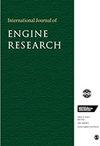实用低温汽油燃烧技术,用于高效率的非公路、中型和重型发动机
IF 2.1
4区 工程技术
Q2 ENGINEERING, MECHANICAL
引用次数: 0
摘要
低温汽油燃烧(LTGC)与添加剂混合燃料喷射(AMFI)是一种新的燃烧策略,经证实,在工作图上,其制动热效率比类似尺寸的市场领先柴油发动机高出 9%-25% 。此外,LTGC-AMFI 发动机的烟雾几乎为零,氮氧化物排放量比柴油机低 4-100 倍,低到无需后处理或仅需被动氮氧化物后处理即可满足要求(无需使用柴油机排气液)。LTGC-AMFI 燃烧是基于对稀释装料进行动力学控制的压缩点火,其中含有可变数量的中低燃料分层。通过在每个发动机循环中向燃料中添加微量的点火增强添加剂来控制其反应性,从而实现快速燃烧控制。采用这种策略,一台中型(MD)LTGC-AMFI 发动机在怠速至 16.3 巴 BMEP 负载和 600 至 2400 转/分钟转速范围内使用普通 E10 汽油,这几乎涵盖了典型 MD 发动机的整个运行图。涡轮输出温度足以让氧化催化剂控制碳氢化合物和一氧化碳的排放。使用该技术的 6 级卡车在 GEM ARB 瞬态和 GEM 55 mph Cruise 驾驶循环中进行的 Autonomie 模拟显示,燃油经济性分别为 8.1 和 11.4 mpg 汽油当量,与类似尺寸的柴油发动机相比,分别提高了 18.6% 和 13.4%。发动机排出的氮氧化物排放量分别为 0.024 和 0.01 g/bhp-h,远低于美国现行的排放标准。这些结果表明,从柴油发动机转向 LTGC-AMFI 发动机将大大减少非道路、MD 和 HD 应用中的温室气体排放,由于电气化在可预见的未来并不现实,这些应用将继续依赖内燃机。与柴油相比,LTGC-AMFI 发动机的油耗更低、汽油成本更低、后处理成本更低,因此总拥有成本也大大降低。本文章由计算机程序翻译,如有差异,请以英文原文为准。
Practical low-temperature gasoline combustion for very high efficiency off-road, medium- and heavy-duty engines
Low-temperature gasoline combustion (LTGC) with additive-mixing fuel injection (AMFI) is a new combustion strategy that has been demonstrated to deliver 9%–25% better brake thermal efficiency than similar-sized market-leading diesel engines over the operating map. Moreover, the LTGC-AMFI engine shows near-zero smoke, and NOx emissions are 4–100 times lower than those of a diesel, sufficiently low that no aftertreatment, or only passive NOx aftertreatment, would be sufficient (diesel exhaust fluid is not required). LTGC-AMFI combustion is based on kinetically controlled compression ignition of a dilute charge with a variable amount of low-to-moderate fuel stratification. Fast combustion control is provided by adding minute amounts of an ignition-enhancing additive into the fuel each engine cycle to control its reactivity. This strategy was used to operate a medium-duty (MD) LTGC-AMFI engine at loads from idle to 16.3 bar BMEP and speeds from 600 to 2400 rpm with regular E10 gasoline, which covers nearly the entire operating map of a typical MD engine. Turbine-out temperatures were sufficient for an oxidation catalyst to control hydrocarbon and CO emissions. Autonomie simulations over the GEM ARB Transient and the GEM 55 mph Cruise driving cycles for class-6 trucks using this technology showed fuel economies of 8.1 and 11.4 mpg-gasoline-equivalent, respectively, corresponding to 18.6% and 13.4% improvements over a similar-size diesel engine. Engine-out NOx emissions were 0.024 and 0.01 g/bhp-h, respectively, well below current U.S. emission standards. These results show that switching from diesel to LTGC-AMFI engines would greatly reduce greenhouse gas (GHG) emissions for off-road, MD and HD applications, which will continue to rely on combustion engines because electrification is not practical in the foreseeable future. With their reduced fuel consumption, the lower cost of gasoline compared to diesel fuel, and much lower aftertreatment costs, LTGC-AMFI engines also offer a significantly lower total cost of ownership.
求助全文
通过发布文献求助,成功后即可免费获取论文全文。
去求助
来源期刊

International Journal of Engine Research
工程技术-工程:机械
CiteScore
6.50
自引率
16.00%
发文量
130
审稿时长
>12 weeks
期刊介绍:
The International Journal of Engine Research publishes high quality papers on experimental and analytical studies of engine technology.
 求助内容:
求助内容: 应助结果提醒方式:
应助结果提醒方式:


